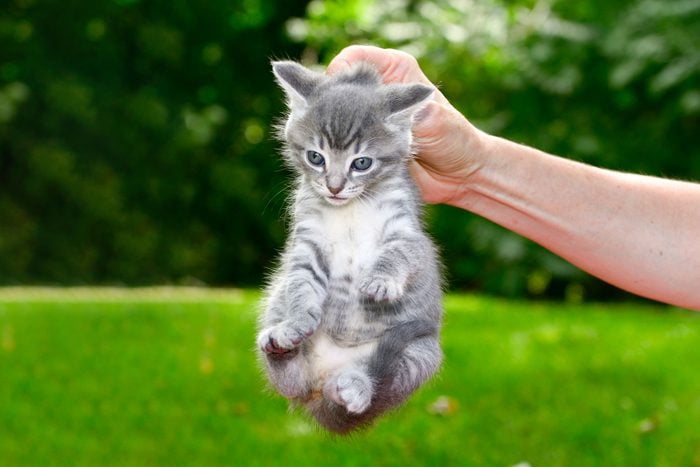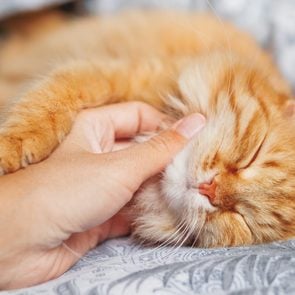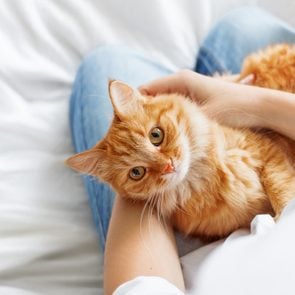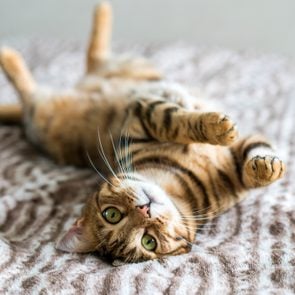What Is Scruffing a Cat—and Why Is It Such a Bad Idea? Vets Explain
Updated: Apr. 13, 2024

Here's why vets advise against scruffing a cat, a restraining technique that could cause pain, anxiety and more
Cats are nothing if not independent. But every now and then, you need to persuade your cat to do something you want it to do—get in the carrier or get off the dining room table, for instance. And you may have heard that the best way to corral them is by scruffing a cat—that is, grab them by the loose skin at the back of their neck.
Maybe you’ve read about it in books about cat facts, cat training and cat behavior, or maybe you’ve even seen a vet do it, subduing an angry cat with a single scruff, like some kind of magical Vulcan neck pinch. But is scruffing a cat really a good idea? Or is it just one more thing to add to the list of things you do that your cat hates? We talked to veterinary experts to find out.
Get Reader’s Digest’s Read Up newsletter for pet insights, humor, cleaning, travel, tech and fun facts all week long.
What is scruffing, exactly?
Scruffing is a method of restraining a cat by grasping hold of the loose skin over the cat’s neck—known as the scruff—and holding so tightly that the cat is immobilized. “The idea is to restrain them to the point that the cat cannot turn or move so they wouldn’t be able to bite or scratch,” says Leslie Sinn, DVM, a veterinarian and feline behaviorist in Ashburn, Virginia. “It usually does immobilize the cat, but it’s a pretty extreme form of restraint.”
For decades, vets were taught to scruff cats as a method of restraining them, but in recent years, there’s been a move away from the practice. Both the American Association of Feline Practitioners and the International Society of Feline Medicine have issued guidelines discouraging the use of scruffing. “In the last several years, we’ve moved toward fear-free techniques that are more respectful to the animals,” says Vered Bar, VMD, a San Francisco–based veterinarian. “Vet visits can be very stressful to cats already, and we try to do things in a way that reduces that stress and makes them feel more comfortable.”
When are cats typically scruffed?
Traditionally, one of the reasons given for scruffing a cat has been that it mimics the way cats behave in the wild, says Caitlin Dutcher-Lundy, RVT, a veterinary technician in Dublin, Ohio. “But there are really only two situations when scruffing happens in a natural setting.”
When a mom cat is moving her kittens
When kittens are very young and not able to safely walk on their own, mom cats will loosely grasp the scruff of their kittens in order to transport them. “At that stage in their development, gently grasping the kittens at the base of the neck often causes them to hang limply and relax,” says Dr. Sinn. “But these are teeny, tiny kittens, not full-grown cats.” That kitten reflex, called a flexor reflex, disappears as the kittens grow.
When cats are mating
Mating can be painful for female cats, since the male cat’s penis is covered in tiny keratin spines that are believed to trigger ovulation in the queen cat. As a result, the female will often attack the male. “In a mating situation, the tomcat will bite the back of the neck to get the queen cat to stay in place,” says Dutcher-Lundy.
Why is scruffing a cat such a problem?
“Scruffing is an extreme form of restraint,” says Dr. Sinn. “It’s not comfortable, and it’s very, very scary for the cat. You can imagine, if someone grasped you by the hair at the base of your neck, it would not exactly be a reassuring circumstance or situation. As veterinary medicine has evolved, we’ve found that it’s more and more important to try and work with the animal and provide a more comfortable experience for them.” In fact, there are a number of reasons to avoid scruffing a cat.
It can be terrifying
While there’s no denying the fact that many cats will actually freeze when they are scruffed, it’s not so much a reflex response as a psychological one. “They’re terrified,” says Dr. Sinn. “It’s not that they’re cooperative, and it’s not that there’s some kitten reflex kicking in. It’s that they’re paralyzed because they’re scared.”
It can be physically painful
“Scruffing is not a kind way to handle a cat,” says Dr. Bar. “Cats don’t like to be told what to do, and when you force them into a position, it’s painful for them.” Because adult cats don’t have that kitten reflex to go limp when grasped by the scruff, holding them in that position requires a tight grip. “A lot of times when you’re scruffing, you’re using some force to keep the cat still,” says Dutcher-Lundy. “You’re pinching the skin tightly, and that’s painful for a cat, especially when it’s a senior or geriatric cat and you’re dealing with arthritis and things like that.”
It stresses them out
Chances are, any cat that’s been packed in a carrier and transported to the vet’s office is already feeling a little stressed. And having someone grab them by the neck will only make things worse. “It heightens their stress level and their negative experience at the veterinary office,” says Dutcher-Lundy. “And cats remember that. It makes them hate the overall veterinary experience, and every time they come back they’re more and more stressed.”
It can influence their test results
All that stress at the vet’s office may give an inaccurate picture of what’s really going on with your cat’s health. “If an animal is super stressed out, the odds are that their physical findings are going to be abnormal,” says Dr. Sinn. “You’ll have high heart rate, high respiratory rate, potentially high body temperature. And it can actually skew lab values as well because they release so much cortisol and adrenalin.”
It can damage your relationship with your cat
The fear your cat feels when scruffed may eat away at the bond you’ve formed with your pet. “Like any other traumatic event, it depends on the individual,” says Dr. Sinn. “But we are biologically designed to remember traumatic experiences so we can avoid them in the future. And we don’t want our cats looking at us as traumatic experiences to be avoided. You don’t want to be someone your cat fears.”
It can make some cats more aggressive
While scruffing might make some cats freeze, other cats will lash out in fear. “There are some cats whose response is just to get really, really angry,” says Dr. Sinn. “And in those situations, they can turn into buzz saws, and they can inflict major injuries.”
Should you ever scruff a cat?
“Definitely not,” says Dutcher-Lundy. “There are much better ways to restrain a cat.” And more and more veterinary professionals seem to agree. But experts do allow for its use in rare situations, such as if the cat is in danger or is posing a danger to others. “If an owner is in a situation where they have to restrain a cat for the cat’s safety, then you do what you need to do,” says Dr. Sinn. “But scruffing should always be a last resort because it’s risky for the handler and it’s bad news for the cat.”
What should you do instead of scruffing a cat?
Depending on the situation, there are alternatives to scruffing that can be safer and more comfortable for both you and your cat. “The no-scruffing movement is part of a shift toward a more respectful handling of cats,” says Dutcher-Lundy, who trains staff and clients at her Ohio clinic in low-stress, cat-friendly restraint techniques. “It lets the cats decide how they want to be handled. Some cats do better if they’re sitting up. Some want to hide under a towel. You have to pay attention to a cat’s body language and do what works best for your cat.”
When you need to get your cat in a carrier
If you want to get your cat in a carrier without getting clawed, you should spend some time getting them used to the carrier, so they don’t associate it only with trips to the vet. But if there’s an emergency and you need to get your cat now, the best way might be to use a towel or blanket to bundle them up. “Throw a big fluffy towel or blanket over the cat and scoop him up and into the carrier,” says Dr. Sinn. “It will be less painful than scruffing him, and the cat would be less likely to struggle.”
At the vet’s office
Many vets now use fear-free and cat-friendly techniques to accomplish physical exams and procedures at their clinics. “The goal is to relax them so you can do procedures without having to restrain them at all,” says Dr. Bar. That may mean covering the cat lightly with a towel to give them a sense of being hidden, or distracting them with the best cat treats while on the exam table. “Sometimes, we’ll give them treats while we’re giving them a vaccine and they don’t even notice the shot,” says Dr. Bar. “There are also some very safe sedatives to give cats at the hospital to just relax them so you can do things without having to restrain them.”
When you need to trim your cat’s claws
For nail clipping, many vet offices suggest the “kitty burrito” technique, where you wrap the cat in a snuggly bath towel. “You just kind of wrap them up like a burrito and take whatever paw you need out one at a time,” says Dutcher-Lundy. “You’d be surprised by how calm and relaxed that can make them.”
When you want to discourage bad behavior
When cats act out, there’s always a reason for their behavior, and scruffing them will never make them change what they’re doing. “Scruffing is not for disciplinary action, or to get a cat to do what you want,” says Dutcher-Lundy. Instead, there are way more effective ways to get your cat to stop peeing on the carpet or bullying another cat. The trick is to figure out what is motivating the bad behavior and remedy that situation.
When you need to remove them from a dangerous situation
If your cat is in physical danger—say they’ve climbed out on a ledge or squared off against another animal—you’ll want to extricate them from the situation however you can. But that doesn’t necessarily mean you need to use scruffing. “Again, the best alternative is to toss a towel or blanket over him and scoop him up,” says Dr. Sinn. “You want to kind of swaddle him so he can’t nip or scratch. And use that as a safe barrier to get the cat where you need them to go.”
About the experts
- Leslie Sinn, DVM, is a veterinarian and the founder of Behavior Solutions in Ashburn, Virginia. She is also a board-certified specialist (known as diplomates) of the American College of Veterinary Behaviorists.
- Caitlin Dutcher-Lundy, RVT, is a registered veterinary technician and director of clinic operations at Faithful Friends Veterinary Clinic in Dublin, Ohio. She has spent most of her time working in feline-only medicine, and she is Cat Friendly Certified.
- Vered Bar, VMD, MLAS, is chief of service veterinarian for primary care at the San Francisco Animal Medical Center. She graduated from veterinary school at the University of Pennsylvania, and her professional interests include surgery, internal medicine, oncology and urgent care.
Sources:
- American Association of Feline Practitioners: “2019 Respectful Handling of Cats to Minimize Fear and Pain at the Veterinary Visit”
- International Society of Feline Medicine: “Pledge to Go ‘Scruff-Free'”
- International Society of Feline Medicine: “About ISFM”



